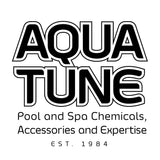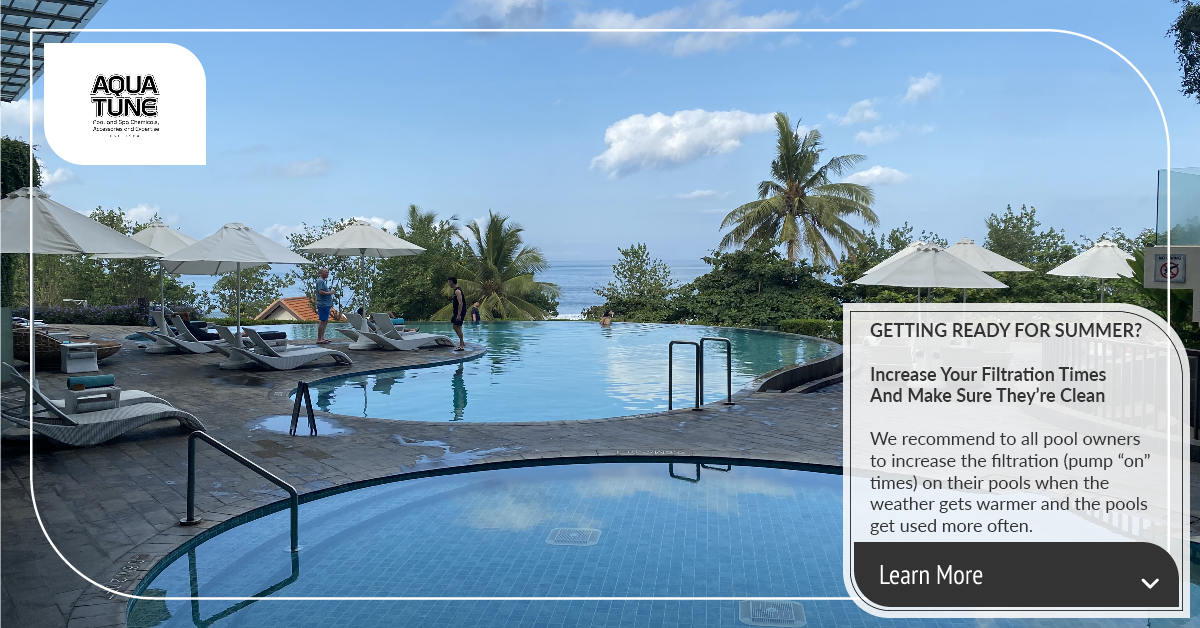
With the rapid onset of Summer (it’s going to be a hot one!), it’s important to change up a few things in your pool to get it safe and ready for your family and friends to enjoy.
For Salt Water-Chlorinated Pools
The by-products in producing active chlorine from salt are predominantly alkaline. Left untreated, these can result in high pH (7.7 and above) and resultant loss of chlorine efficacy with every pH rise.
Low pH (below 7.0) is more often the result of overuse of acid. pH can be lowered using chemicals such as dry acid.
If too much acid is added to the pool and the pH is pushed below 6.8, you may have created an “acid bath” and lose all your Alkalinity. If this is the case, you will need to add a pH increaser to get your pH back to around 7 before you can add Alkalinity Increaser (pH Up).
Sanitation And Water Balance
Daily attention to chlorine and pH should be the norm in the swim season as both can change rapidly.
Total Alkalinity, hardness and stabiliser (outdoor pool) are important too, but remain fairly steady on a daily basis.
Home test kits or quality test strips are the best way to monitor chlorine pH and Alkalinity regularly.

Increase Your Filtration Times And Make Sure They’re Clean
Appropriate Filtration is a major factor in maintaining a clean pool.
We recommend to all pool owners to increase the filtration (pump “on” times) on their pools when the weather gets warmer and the pools get used more often.
For a small sized pool (under 40,000 litres) in the shade, a minimum filtration time would be approximately 6 hours with a single speed pump.
If your pool is in full sun; has a variable speed pump on a low setting (less litres per minute going through it); or is a larger size, up to 10-12 hrs per day may be required.
Mark sure your cartridge filter is clean and functioning. If you have a sand/glass filter, that the pressure is near the system baseline (backwash and rinse if necessary).
For Inline Tablet Feeders And Floats
Unlike liquid or granular chlorine, trichlor tablets are highly acidic. They need to be counterbalanced with a background of Total Alkalinity in the range of 130-150 mg/l instead of the 80-120 mg/l with a salt pool.
If Alkalinity increaser is not added week by week, the pH will keep lowering and eventually go below 7.0 or less, leading to corrosive water and irritation to eyes, ears and skin. Once the pH drops lower than this, a pH increaser is needed to boost the pH before an Alkalinity increaser can be added. Adjusters and Balancers are vailable here

For Ioniser Pools
The Copper/Silver approach to disinfection contributes no oxidising function. An oxidizer is essential to convert contaminants to filterables and, as a consequence, give clean, sparkling water.
Most ioniser customers tend not to use chlorine but rely on a non-chlorine oxidizer. This is usually Potassium Monopersulphate (Shockright, Aquabrite, Oxy_plus etc).
If using chlorine, only use liquid chlorine or dichlor (has a low pH) as there is a lack of metals. Metals can have adverse effects on your ioniser.
For Hand-Dosing
If using granular chlorines, mix the chlorine with water in a bucket, stir and pour what has dissolved evenly around the pool. Repeat several times. Any solids left are calcium waste. Throwing undissolved granular chlorine into the pool eventually leads to excess hardness and scaling problems.
If using Dichlor or Trichlor also pre-dissolve and spread around the pool. Avoid constant use of these products which will lead to over-stabilising and over-protecting the chlorine used. So-called ‘chlorine lock’ is a bit of a myth.
While these products are often promoted as applied through the skimmer box, we highly recommend the above approach instead.
Bromine
A very acidic product so treat similarly to Trichlor. With good alkalinity, acid additions should be unnecessary.
Bromine will burn up fast when exposed to sunlight so it’s really only suitable for indoor pools out of direct sunlight.
Bromine is great for heated indoor pools as it is heat stable and will only dissipate when it has something to sanitise.
Bromine can be great for spas, but constant monitoring is required to make sure the Bromine levels don’t increase unchecked.
Have you got a specific question for us that hasn’t been answered? Follow this link and share your question with us… https://www.aquatune.net.au/pages/quick-favour
Best regards,
Team Aquatune
P.S. Do you look after your pool or spa yourself? Join our Do-It-Yourself Pool and Spa Maintenance community here… https://www.aquatune.net.au/pages/diy
